Ven Pongal, a beloved South Indian comfort food, is the perfect dish when you’re craving something warm, filling, and soothing. Made from a simple combination of rice and moong dal (split yellow lentils), it’s cooked together until soft and creamy, almost like a savory porridge. The gentle texture makes it easy on the stomach, yet incredibly satisfying.
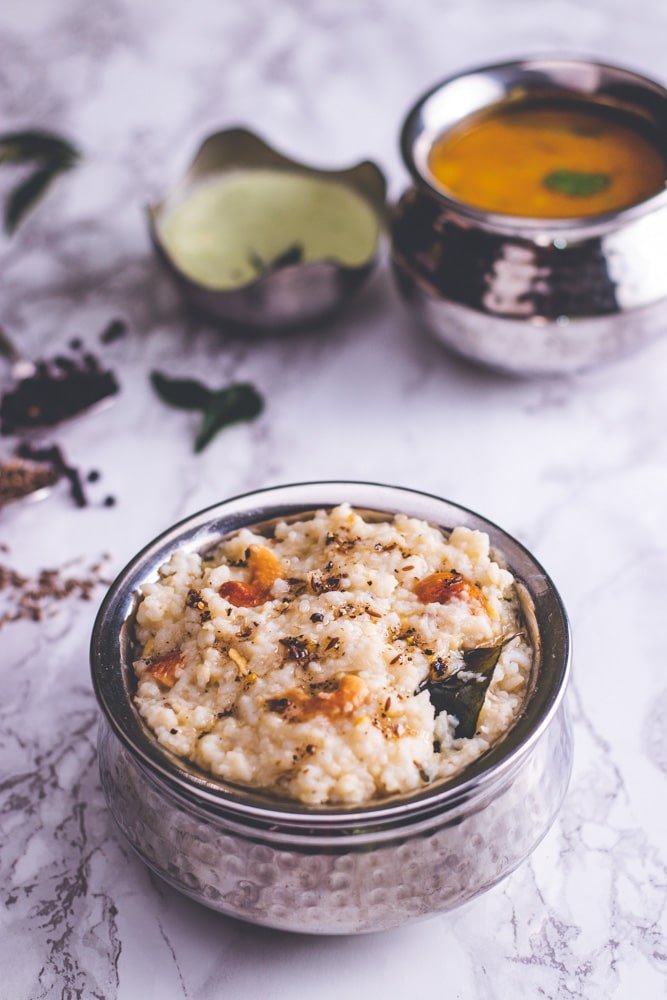
What truly brings Ven Pongal to life is the aromatic tempering (tadka). A generous spoonful of ghee (clarified butter) is heated and infused with whole cumin seeds, cracked black pepper, fresh curry leaves, and finely chopped ginger. As soon as this sizzling tadka hits the soft rice-dal mixture, it releases a heavenly aroma that fills your kitchen with warmth and comfort.
The richness of ghee, the earthiness of lentils, and the subtle heat from the black pepper come together in perfect harmony. It’s a dish that feels both nourishing and indulgent, despite using minimal ingredients.
Ven Pongal is traditionally served hot, often with coconut chutney and tangy sambar on the side, making it a wholesome meal enjoyed during breakfast or festive occasions like the Pongal festival. But it’s just as good on a regular day when you want something quick, soul-soothing, and deeply flavorful.
What is Ven pongal?
Ven Pongal, also known as Khara Pongal, is a traditional South Indian dish made from rice and yellow moong dal, simmered together until they reach a soft, creamy, porridge-like consistency. The term “Ven” refers to the savory version of Pongal, as opposed to the sweet variation (Sakkarai Pongal). The combination of rice and lentils makes this dish wholesome, nourishing, and naturally comforting.
In the olden days, Pongal was prepared in clay pots over a wood fire, especially during special occasions and festivals. The slow cooking over firewood imparted a smoky, rustic flavor. Today, it’s more common to make it in a pressure cooker or Instant Pot, which drastically reduces the cooking time without compromising on taste or texture.
Ven Pongal is often referred to as the South Indian counterpart of moong dal khichdi, though its flavor profile is quite distinct due to the use of a fragrant tempering. Ghee is infused with cumin seeds, whole black peppercorns, fresh ginger, curry leaves, and a pinch of asafoetida, and this tadka is poured over the soft rice-dal mixture, creating a dish that’s rich, aromatic, and soothing.
Ven Pongal is not just a popular breakfast but also a sacred dish offered to deities during pujas, especially during the Thai Pongal harvest festival.
Ven Pongal is gentle on the stomach and easily digestible, making it suitable for people of all ages. Today’s recipe is a basic version, but many modern adaptations use millets, oats, semolina, or quinoa for added nutrition and dietary preferences.
Ingredients:
Main Ingredients:
- 1 cup short-grain rice (Sona Masoori preferred): Sona Masoori is a soft, aromatic short-grain rice variety often used in South Indian kitchens for its light texture and quick cooking time. It gives the perfect soft, mushy texture ideal for Ven Pongal. You can also use other short-grain varieties if this is unavailable.
- ⅓ cup yellow moong dal (split and skinless): Moong dal lends a soft, creamy consistency and a subtle nutty taste to the dish. It’s light on the stomach and easy to digest, making it a staple in many traditional recipes like Pongal and khichdi.
- 4½ cups water: This amount of water is needed to cook the rice and dal until they reach a porridge-like consistency. Adjust slightly if using a different rice type.
- Salt to taste: Add salt as per your preference. It’s best to adjust it after cooking since water quantity can influence the overall flavor balance.
For Tempering (Tadka):
- 1 teaspoon cumin seeds: These add a warm, earthy aroma and enhance the depth of the dish.
- ½ teaspoons whole black peppercorns: They provide subtle heat and pair wonderfully with the richness of ghee.
- 1 tablespoon oil: Used to roast the whole spices initially. You can use any neutral-flavored oil.
- 3 tablespoons ghee (clarified butter): Ghee brings richness, aroma, and an unmistakable flavor essential to traditional Ven Pongal.
- 5–6 cashew nuts, halved: Cashews add a pleasant crunch and mild sweetness that balances the soft, savory base of the dish.
- 8–10 curry leaves: These aromatic leaves infuse the dish with a classic South Indian flavor.
- 2 teaspoons ginger, finely chopped or grated: Ginger adds freshness and aids digestion.
- ¼ teaspoon hing (asafoetida): A small amount brings a rich undertone and elevates the flavor profile of the entire dish.
Preparation for khara pongal recipe:
1) Start by placing moong dal in a dry pan and gently roasting it over medium-low heat, stirring often to avoid burning and ensure it toasts evenly.
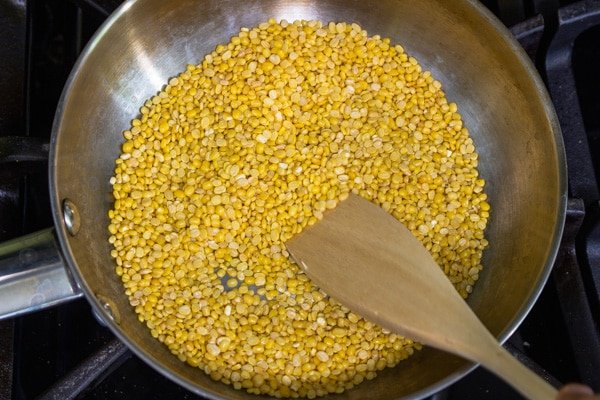
2) Roast the dal until it turns slightly golden and gives off a nutty, toasted aroma. This step takes just a few minutes but greatly enhances the flavor. Transfer the roasted dal to a bowl and keep it aside.
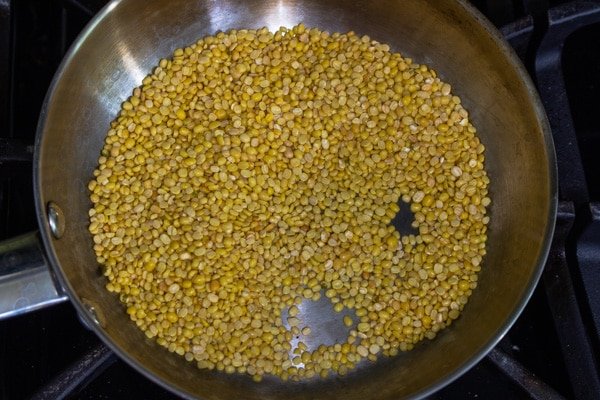
3) In the same pan, briefly toast the rice for 2–3 minutes until aromatic. This optional step enhances the flavor subtly. Transfer to the same bowl with the dal.
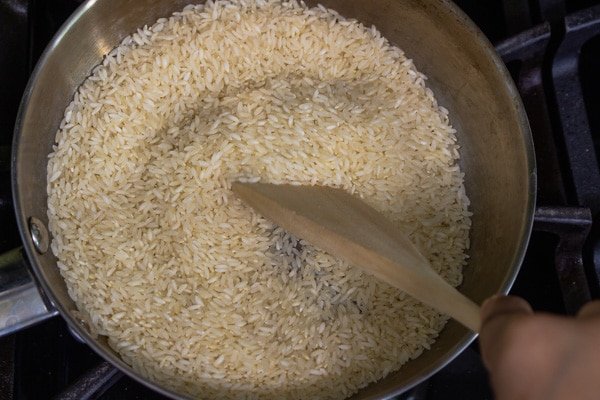
Cooking the Pongal
1) Once the roasted rice and dal have cooled slightly, wash them thoroughly under running water. Rinse until the water runs clear and is no longer cloudy.

2) Transfer the washed rice and dal into a pressure cooker. Add salt to taste.
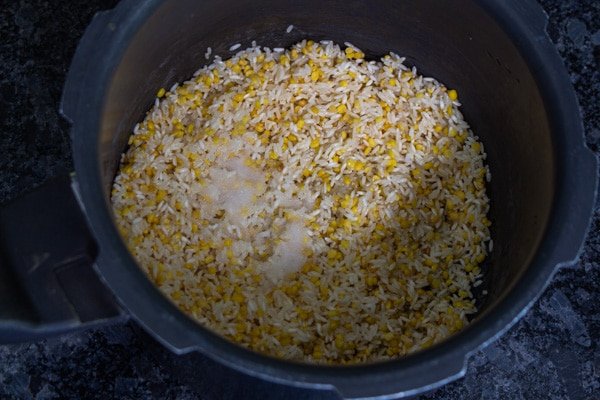
3) Pour in the measured water and stir to combine everything well.

4) Close the lid, attach the pressure regulator, and cook on medium heat for 4 to 5 whistles. Once done, allow the pressure to release naturally. Open the lid and check—both the rice and dal should be very soft and fully cooked.

5) Stir the mixture well until it turns creamy and porridge-like. If it feels too thick or dry, add a little hot water and stir until smooth and silky.
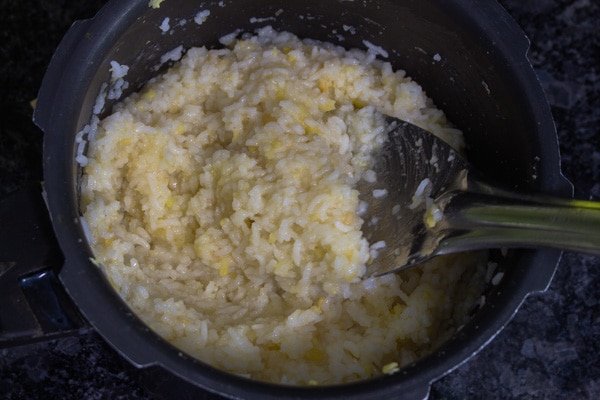
6) While the pongal is cooking, take cumin seeds and black peppercorns in a mortar and pestle.
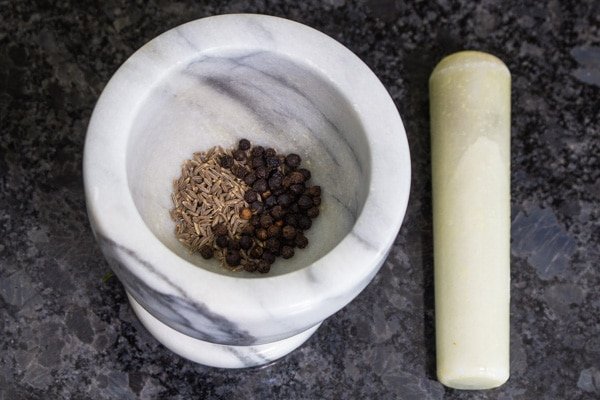
7) Coarsely crush them and set aside. You can also use a spice grinder if preferred.
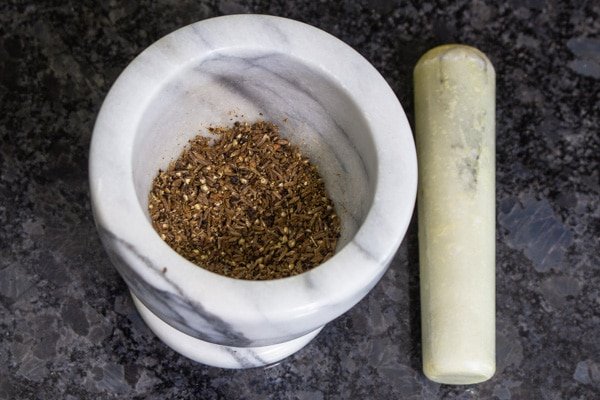
8) In a small pan, heat ghee and oil over medium heat.

9) Add cashew nuts and fry until golden and crisp. Keep an eye on them—they brown quickly.
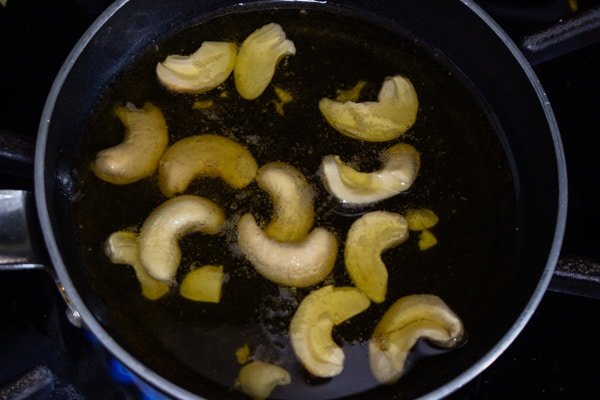
10) Next, add curry leaves, minced ginger, and a small pinch of hing to the hot ghee. Let everything sizzle for a few seconds.

11) Add the crushed cumin and pepper, stirring briefly until their aroma is released.
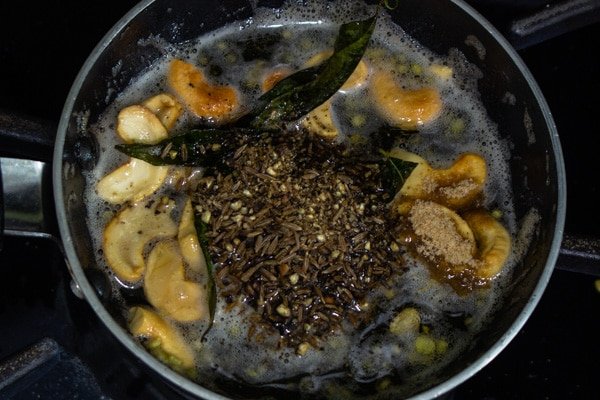
12) Immediately pour this hot tempering over the cooked pongal.
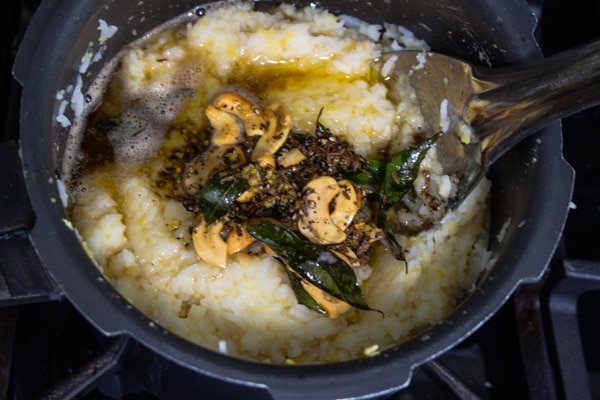
13) Mix everything thoroughly so the flavors are evenly distributed. Your Ven Pongal is ready to be served—steaming hot, aromatic, and full of comforting flavors.

Tips to make the BEST Ven pongal:
1) Don’t cut back on the ghee:
Ghee is essential—not just for flavor, but also for texture. It adds richness, a wonderful aroma, and helps keep the pongal soft and smooth. Reducing it may result in a sticky, less appetizing texture.
2) Make a spice blend ahead of time:
You can prepare a coarse mixture of cumin seeds and black peppercorns in bulk using a spice grinder or mortar and pestle. Keep it in an airtight jar and use as needed. This versatile blend also works well in rasam, rava idli, and rava dosa, saving time in regular South Indian cooking.
3) Dry roast moong dal in batches:
Dry roasting moong dal boosts its nutty aroma and improves its digestibility. You can roast a larger quantity in advance and store it in an airtight jar for up to 1–2 months, making future Pongal prep even quicker.
4) Roasting rice is optional:
Toasting the rice enhances its aroma, but it’s optional and can be skipped when short on time.
5) Use short-grain rice:
Traditionally, Pongal is prepared using local short-grain rice varieties, which give the best soft and creamy texture. At home, I prefer using Sona Masoori, but any short-grain rice will work well.
6) Adjust dal-to-rice ratio to taste:
For a richer taste and creamier texture, increase the amount of dal. You can easily modify the rice-to-dal ratio based on your taste and desired consistency.

What to serve with ven pongal?
1) With Coconut Chutney
Ven Pongal dyads beautifully with a classic South Indian coconut chutney. The cool, delicate texture of the chutney provides a stimulating discrepancy to the warm, spiced rice and dal. You can make it plain with coconut and green chili or enhance it with roasted chana dal and tempered mustard seeds for added flavor.
2) With Sambar – A Traditional fave
One of the most popular and satisfying combinations is Ven Pongal with sambar. The slightly pungent, vegetable-rich lentil stew complements the soft, ghee-laden Pongal impeccably. This quintet is so well-loved that it’s frequently served in South Indian cafes and tabernacles as a complete mess.
3) As a Full mess
To transfigure Pongal into a hearty and wholesome lunch or regale, serve it with coconut chutney, sambar, and many extras on the side. Add a roasted or fried papad for crunch and a spoonful of fix for a burst of pungent-racy flavor. This balanced mess brings together multiple textures and flavors on one plate.
4) For Gleeful Occasions or Pooja Meals
During carnivals like Thai Pongal or for Naivedyam( offering to divinities), Ven Pongal is served as part of a traditional South Indian spread. It frequently sits alongside sweet pongal, vadai, payasam, and banana splint incidents.
5) Stylish Served Hot
Ven Pongal is stylish served piping hot, straight from the pot. However, just add a splash of hot water and stir to restore its smooth texture before serving, if it thickens over time.
